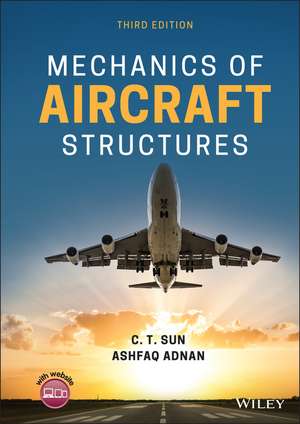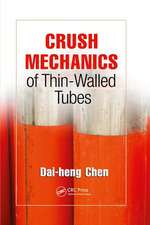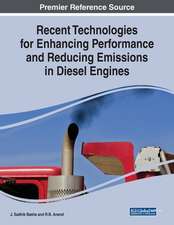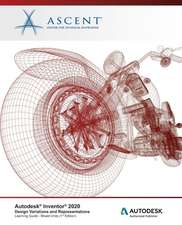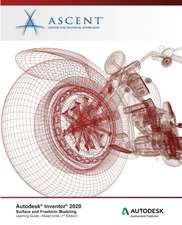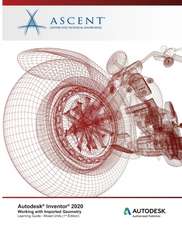Mechanics of Aircraft Structures 3e
Autor CT Sunen Limba Engleză Hardback – 23 aug 2021
The newly revised Third Edition of Mechanics of Aircraft Structures delivers a combination of the fundamentals of aircraft structure with an overview of new materials in the industry and a collection of rigorous analysis tools into a single one-stop resource. Perfect for a one-semester introductory course in structural mechanics and aerospace engineering, the distinguished authors have created a textbook that is also ideal for mechanical or aerospace engineers who wish to stay updated on recent advances in the industry.
The new edition contains new problems and worked examples in each chapter and improves student accessibility. A new chapter on aircraft loads and new material on elasticity and structural idealization form part of the expanded content in the book. Readers will also benefit from the inclusion of:
- A thorough introduction to the characteristics of aircraft structures and materials, including the different types of aircraft structures and their basic structural elements
- An exploration of load on aircraft structures, including loads on wing, fuselage, landing gear, and stabilizer structures
- An examination of the concept of elasticity, including the concepts of displacement, strain, and stress, and the equations of equilibrium in a nonuniform stress field
- A treatment of the concept of torsion
Preț: 916.09 lei
Preț vechi: 1254.93 lei
-27% Nou
Puncte Express: 1374
Preț estimativ în valută:
175.35€ • 190.53$ • 147.39£
175.35€ • 190.53$ • 147.39£
Carte tipărită la comandă
Livrare economică 21 aprilie-05 mai
Preluare comenzi: 021 569.72.76
Specificații
ISBN-13: 9781119583912
ISBN-10: 1119583918
Pagini: 320
Dimensiuni: 178 x 254 x 19 mm
Greutate: 0.77 kg
Ediția:3rd Edition
Editura: Wiley
Locul publicării:Hoboken, United States
ISBN-10: 1119583918
Pagini: 320
Dimensiuni: 178 x 254 x 19 mm
Greutate: 0.77 kg
Ediția:3rd Edition
Editura: Wiley
Locul publicării:Hoboken, United States
Cuprins
CONTENTS
Preface xiii
Preface to the First Edition xv
1 Characteristics of Aircraft Structures and Materials 1
1.1 Introduction / 1
1.2 Types of Aircraft Structures / 1
1.2.1 Fixed-wing Aircraft / 1
1.2.2 Rotorcraft / 2
1.2.3 Lighter-than-air Vehicles / 2
1.2.4 Drones / 2
1.3 Basic Structural Elements in Aircraft Structure / 3
1.3.1 Fuselage / 3
1.3.2 Wing / 3
1.3.3 Landing Gear / 3
1.3.4 Control Surfaces / 4
1.4 Aircraft Materials / 4
Problems / 6
2 Loads on Aircraft Structures 7
2.1 Introduction / 7
2.2 Basic Structural Elements / 7
2.2.1 Axial Member / 7
2.2.2 Shear Panel / 8
2.2.3 Bending Member (Beam) / 9
2.2.4 Torsion Member / 10
2.3 Wing and Fuselage / 11
2.3.1 Load Transfer / 11
2.3.2 Wing Structure / 12
2.3.3 Fuselage / 13
Problems / 15
3 Introduction to Elasticity 18
3.1 Introduction / 18
3.2 Concept of Displacement / 19
3.3 Strain / 21
3.4 Stress / 26
3.5 Equations of Equilibrium in a Uniform Stress Field / 28
3.6 Equations of Equilibrium in a Nonuniform Stress Field / 30
3.7 Stress Vector-Stress Component Relations / 32
3.8 Principal Stress / 34
3.9 Shear Stress / 37
3.10 Stress Transformation / 39
3.11 Linear Stress-Strain Relations / 41
3.11.1 Strains Induced by Normal Stress / 42
3.11.2 Strains Induced by Shear Stress / 45
3.11.3 Three-Dimensional Stress-Strain Relations / 46
3.12 Plane Elasticity / 51
3.12.1 Stress-Strain Relations for Plane Isotropic Solids / 51
3.12.2 Stress-Strain Relations for Orthotropic Solids in Plane Stress / 54
3.12.3 Governing Equations / 55
3.12.4 Solution by Airy Stress Function for Plane Isotropic Solids / 58
3.12.5 Plane Elasticity Solutions in Polar Coordinate System / 60
3.13 Formulations Beyond 2D Plane Elasticity / 64
Problems / 66
4 Torsion 74
4.1 Introduction / 74
4.2 Torsion of Uniform Bars with Arbitrary Cross-section/ 75
4.2.1 Governing Equations / 75
4.2.2 Boundary Conditions / 78
4.3.3 Torque-Stress Relations / 79
4.3.4 Warping Displacement / 80
4.3.5 Torsion Constant / 80
4.3 Bars with Circular Cross-Sections / 81
4.3.1 Elasticity Approach using Prandtl Stress Function / 81
4.3.2 Mechanics of Solid Approach / 84
4.4 Bars with Narrow Rectangular Cross-Sections / 87
4.5 Closed Single-Cell Thin-Walled Sections / 91
4.5.1 The s-n coordinate system / 91
4.5.2 Prandtl Stress Function / 93
4.5.3 Shear Flow q / 94
4.5.4 Shear Flow - Torque Relation / 95
4.5.5 Twist Angle / 96
4.5.6 Torsion Constant J / 99
4.6 Multicell Thin-Walled Sections / 102
4.7 Warping in Open Thin-Walled Sections / 107
4.8 Warping in Closed Thin-Walled Sections / 111
4.9 Effect of End Constraints / 113
Problems / 120
5 Bending and Flexural Shear 126
5.1 Introduction / 126
5.2 Bernoulli-Euler Beam Theory / 126
5.2.1 Unidirectional Bending on Beams with
a Symmetric Section / 126
5.2.2 Bidirectional Bending on Beams with
an Arbitrary Section / 132
5.3 Structural idealization / 137
5.4 Transverse Shear Stress due to Transverse Force in
Symmetric Sections / 146
5.4.1 Narrow Rectangular Cross-Section / 147
5.4.2 General Symmetric Sections / 148
5.4.3 Thin-Walled Sections / 150
5.34.4 Shear Deformation in Thin-Walled Sections / 151
5.5 Timoshenko Beam Theory / 154
5.6 Saing-Venant's Principle / 158
5.7 Shear Lag / 162
Problems / 165
6 Flexural Shear Flow in Thin-Walled Sections 171
6.1 Introduction / 171
6.2 Flexural Shear Flow in Open Thin-Walled Sections / 171
6.2.1 Symmetric Thin-Walled Sections / 172
6.2.2 Unsymmetric Thin-Walled Sections / 176
6.2.3 Multiple Shear Flow Junctions / 178
6.2.4 Selection of Shear Flow Contour / 179
6.3 Shear Center in Open Sections / 180
6.4 Closed Thin-Walled Sections and Combined Flexural and
Torsional Shear Flow / 186
6.4.1 Shear Center / 187
6.4.2 Statically Determinate Shear Flow / 191
6.5 Closed Multicell Sections / 194
Problems / 198
7 Failure Criteria for Isotropic Materials 205
7.1 Introduction / 205
7.2 Strength Criteria for Brittle Materials / 205
7.2.1 Maximum Principal Stress Criterion / 205
7.2.2 Coulomb-Mohr Criterion / 206
7.3 Yield Criteria for Ductile Materials / 208
7.3.1 Maximum Shear Stress Criterion (Tresca Yield
Criterion) in Plane Stress / 208
7.3.2 Maximum Distortion Energy Criterion (von Mises
Yield Criterion) / 210
7.4 Fracture Mechanics / 215
7.4.1 Stress Concentration / 215
7.4.2 Concept of Cracks and Strain Energy Release Rate / 216
7.4.3 Fracture Criterion / 218
7.5 Stress Intensity Factor / 223
7.5.1 Symmetric Loading (Mode I Fracture) / 223
7.5.2 Antisymmetric Loading (Mode II Fracture) / 225
7.5.3 Relation between K and G / 227
7.5.4 Mixed Mode Fracture / 231
7.6 Effect of Crack Tip Plasticity / 232
7.7 Fatigue Failure / 235
7.7.1 Constant Stress Amplitude / 235
7.7.2 S-N Curves / 235
7.7.3 Variable Amplitude Loading / 236
7.8 Fatigue Crack Growth / 236
Problems / 239
8 Elastic Buckling 244
8.1 Introduction
8.2 Eccentrically Loaded Beam-Column / 244
8.3 Elastic Buckling of Straight Bars / 245
8.3.1 Pinned-Pinned Bar / 247
8.3.2 Clamped-Free Bar / 250
8.3.3 Clamped-Pinned Bar / 251
8.3.4 Clamped-Clamped Bar / 252
8.3.5 Effective Length of Buckling / 253
8.4 Initial Imperfection / 254
8.5 Postbuckling Behavior / 256
8.6 Bar of Unsymmetric Section / 262
8.7 Torsional-Flexural Buckling of Thin-Walled Bars / 265
8.7.1 Nonuniform Torsion / 265
8.7.2 Torsional Buckling of Doubly Symmetric Section / 267
8.7.3 Torsional-Flexural Buckling / 269
8.8 Elastic Buckling of Flat Plates / 275
8.8.1 Governing Equation for Flat Plates / 273
8.8.2 Cylindrical Bending / 275
8.8.3 Buckling of Rectangular Plates / 276
8.8.4 Buckling under Shearing Stresses / 279
8.9 Local Buckling of Open Sections / 280
Problems / 282
9 Analysis of Composite Laminates 287
9.1 Plane Stress Equations for Composite Lamina / 287
9.2 Off-Axis Loading / 293
9.3 Notation for Stacking Sequence in Laminates / 295
9.4 Symmetric Laminate under In-Plane Loading / 296
9.5 Effective Moduli for Symmetric Laminates / 299
9.6 Laminar Stresses / 303
9.7 [±45°] Laminate / 305
Problems / 306
Index 308
